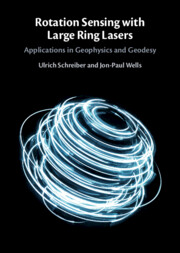Book contents
3 - Large Scale Helium–Neon Gyroscopes
Published online by Cambridge University Press: 02 February 2023
Summary
This chapter discusses the design properties and operational practices of the helium–neon ring laser gyroscope in fine detail. We look atmonolithic ring laser design and explore the advantage of upscaling, which eventually necessitates a heterolithic cavity structure. This requires us to revisit the scale factor stability, beam wander and strain effects. Topics like backscatter correction, sensor sensitivity and a variety of different operation modes, such as single laser mode or the mode-locked regime, are presented and critically discussed. The mitigation of all sorts of obvious and also a large number of unsuspected ring laser error sources is intensively treated and illustrated with a rich body of measurement examples, before the importance and limitations of the cavity mirrors is addressed. This leads us to explore several alternative transitions of neon, before the design and realization of large sensor arrays is described. With the realization of the ROMY ring laser array in the shape of a tetrahedron, we have recovered the full Earth rotation vector. Furthermore, ROMY is also the first six degree of freedom sensor for teleseismic events.
Keywords
- Type
- Chapter
- Information
- Rotation Sensing with Large Ring LasersApplications in Geophysics and Geodesy, pp. 27 - 172Publisher: Cambridge University PressPrint publication year: 2023



